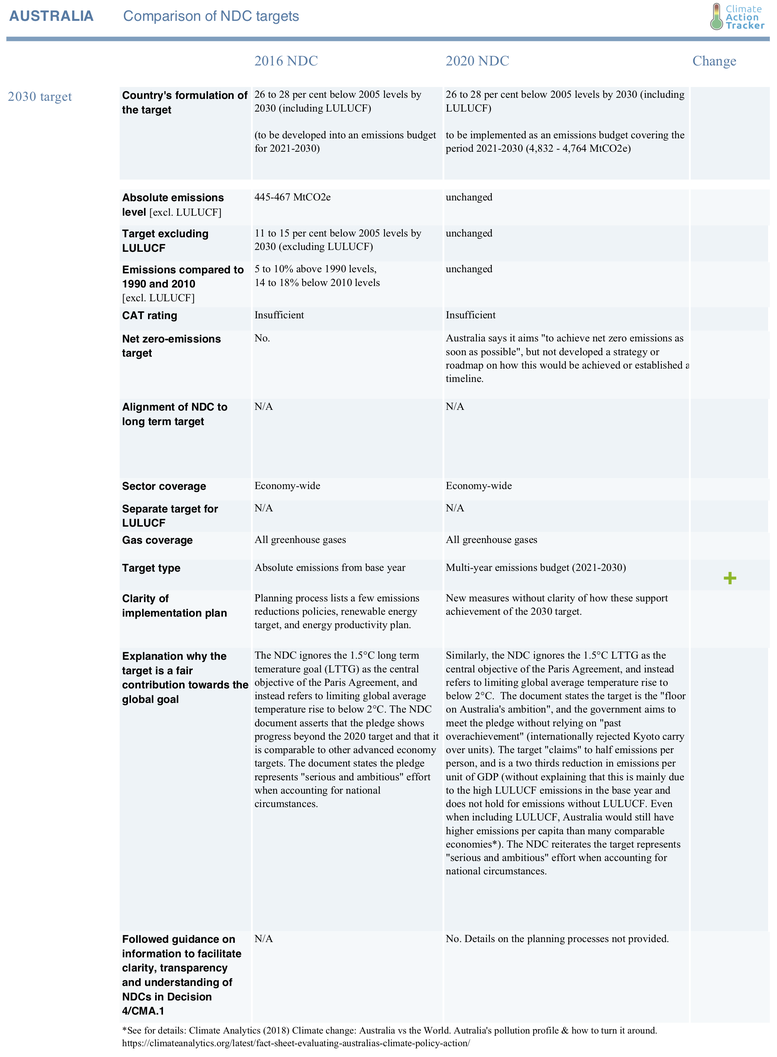CAT Climate Target Update Tracker
Australia
Summary
Australia repeats old target with no increase in ambition
Australia recommunicated its 2015 NDC in late December 2020 and in so doing failed to increase its 2030 target, which the CAT rates as “Insufficient.”
The unchanged target aims to reduce greenhouse gas emissions by 26-28% below 2005 levels by 2030, including LULUCF, translating to just 11-15% below 2005 levels by 2030 when LULUCF is excluded.
Australia’s recommunicated NDC claims that Australia will “overachieve” the target based on government emissions projections. This claim is not, however, supported by Australia’s own actual, recent government projections (based on current policies), which only achieve a reduction of 22% below 2005 by 2030 (incl. LULUCF). In the absence of published quantitative analysis that supports the government’s claim, the argument of overachievement has little or no basis in fact.
So with current policies, Australia would still need to rely on Kyoto carryover units to achieve its target, an approach rejected by other countries with such carryovers. The Australian government claims in its NDC submission that it would not need them, but doesn’t rule out their use.
Only a so-called “Technology sensitivity scenario” (not described in detail in the government projection report but which the government claims, without any published quantitative justification, is aligned with the Technology Investment Roadmap) reaches a reduction by 29% below 2005 levels by 2030 (incl. LULUCF). The communication outlines elements of the Technology Investment Roadmap and some recently-announced measures without quantifying how these measures support achieving the 2030 target.
CAT analysis of NDC recommunication


On 31 December 2020, the Australian Government submitted its NDC recommunication to the UNFCCC without a stronger target, despite global expectations for governments to increase their climate ambition. The submission claims, without any published quantitative basis, that Australia will overachieve its target, but nevertheless fails to increase it.
The NDC recommunication reiterates the old target, which has economy-wide cover, and a fixed percentage reduction range from a base year for 2030. The NDC aims to reduce greenhouse gas emissions by 26-28% below 2005 levels by 2030 including LULUCF. This translates to 11-15% below 2005 by 2030 excluding LULUCF, or an absolute emissions level of 445 to 467 MtCO2e by 2030 excluding LULUCF. The NDC recommunication reconfirms that a budget approach from 2021-2030 will be used, with the budget defined by a linear reduction from the 5% reduction target for 2020. The recommunication does not include further supporting targets, despite the fact its 2020 renewable energy target, included in the previous NDC, has expired.
The NDC states Australia’s policies will advance “Australia’s ambition to achieve net zero emissions as soon as possible, in support of the goals of the Paris Agreement”. Australia has not set a timeline nor a roadmap towards achieving net zero emissions. A long term greenhouse gas emissions reduction strategy is expected before COP26.
The recommunication outlines measures introduced since the first NDC in 2015, but does not quantify the contribution these new measures make towards meeting the target. It states Australia is on track to “meet and beat” the target without relying on Kyoto carryover credits (“past overachievement”) , but this claim is not supported by Australia’s own emissions projections published in 2020. The projections indicate the target will only be met if a “technology sensitivity scenario” based on the Technology Investment Roadmap is followed, but no quantitative detail has been provided as to how this scenario actually achieves the target. The recommunicated NDC does not rule out using carryover credits in the future. However, carryover units were not a credible option as other countries have rejected using this.

Assumptions
The NDC includes LULUCF, and the CAT has estimated levels of emissions excluding LULUCF. See the CAT assessment of Australia for further assumption details.
Australia currently uses AR4 Global Warming Potentials (GWP), reflected in this analysis. The 2020 NDC recommunication indicates Australia intends to apply GWP AR5 in future.
Links
Stay informed
Subscribe to our newsletter